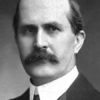William Henry Bragg

William Henry Bragg
Sir William Henry Bragg OM KBE PRSwas a British physicist, chemist, mathematician and active sportsman who uniquely shared a Nobel Prize with his son William Lawrence Bragg – the 1915 Nobel Prize in Physics: "for their services in the analysis of crystal structure by means of X-rays". The mineral Braggite is named after him and his son. He was knighted in 1920...
NationalityBritish
ProfessionPhysicist
Date of Birth2 July 1862
atoms builder constructs kinds limited nature
Let us think of Nature as a builder, making all that we see out of atoms of a limited number of kinds, just as the builder of a house constructs it out of so many different kinds of things: bricks, slates, planks, panes of glass, and so on.
atoms discovery increased individual ten thousand vision
Broadly speaking, the discovery of X-rays has increased the keenness of our vision ten thousand times, and we can now 'see' the individual atoms and molecules.
concerned discuss forms found gives methods necessary older particular rarely rather science shapes whose
The chemist, whose science is immediately concerned with the combinations of atoms, has rarely found it necessary to discuss their shapes, and gives them no particular forms in his diagrams. That does not mean that the shapes are unimportant, but rather that the older methods could not define them.
atoms gas liquid molecules move partners though whereas
The difference between a gas and a liquid is that in the former, the atoms and molecules move to and fro in an independent existence, whereas in the latter, they are always in touch with one another, though they are changing partners continually.